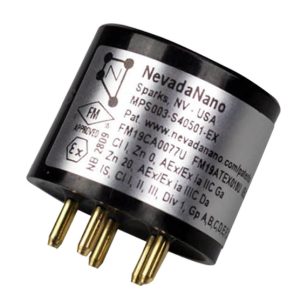MPS™ Refrigerant Sensor R290 Downloads
MPS™ Refrigerant Gas Sensor Brochure:
NevadaNano’s Molecular Property Spectrometer™ (MPS™) Refrigerant Gas Sensors provide accurate and reliable detection of refrigerants in existing and emerging applications. Whether you are converting refrigeration systems to mildly flammable low GWP A2L’s or to highly flammable A3’s or even proactively managing your A1 leaks, the MPS™ has best in class performance. MPS™’s 15+ year lifetime and the industry’s first no field calibration required, provides an attractive total cost of ownership.


The MPS™ platform is hardened to harsh environmental conditions including rapid transients that deliver the best performance with a very low false positive rate. With its extremely fast response time, the accurate sensor output is delivered in seconds. The sensor is immune to poisons and with built-in self-test functions, you are assured the MPS™ sensor is working within specification. The MPS™ comes in two different packaging options. The S4 is hardened for commercial ATEX certified applications, and the cost-effective Mini targets residential applications. Both packages meet the exact same performance standards and can be calibrated for any of the refrigerants listed below.
Features
- Meets UL 60335-2-40 & ASHRAE
15 requirements. - Wide environmental operating range with no cross-sensitivity to rapid T & RH changes.
- No false positives.
- 15+ year lifetime.
- Extremely fast response time.
- Built-in self-test for fail-safe operation.
- Immune to poisoning.
- Industrial and residential
packaging options. - Third-party tested.
- Available now for integration.
MPS™ R-290 Gas Sensor Datasheet:
Overview
NevadaNano’s MPS™ R-290 Sensor builds upon the fifth-generation of this breakthrough sensor technology, delivering industry-leading performance with a low cost of ownership. It quickly detects and quantifies R-290 with unprecedented accuracy, comes already factory calibrated for its entire 15+ year life—no field calibrations are required—and has built-in environmental compensation and automatic self-testing for fail-safe operation. The sensor is robust and inherently immune to poisoning. Readings are output on a digital bus or a configurable analog output.
The MPS™ R-290 Refrigerant Gas Sensors are available in two form factors: the “Mini” form factor, and the certified “intrinsically safe” (IS) S4 form factor.
Features
- Accurate detection of R-290 (propane)
- Built-in environmental compensation
- Compliant to UL 60335-2-40 ed.4
- Compliant to IEC 60335-2-40 ed.7
- Compliant to IEC 60079-29-1:2020
- No calibration required
- Supports 15+ year lifetimes
- Low average power: 27.3 mW typical at 3V
- Can be powered at 3V
- Extremely poison resistant
- Built-in self-test for fail-safe operation
- Custom analog out configurations
- Can detect gas presence at start-up


MPS™ R-290 Gas Sensor User Manual:
How the MPS™ R-290 Sensor Works
The MPS™ R-290 Sensor is a smart sensor with built-in environmental compensation that detects and accurately quantifies R-290, a flammable (A3) refrigerant also known as propane. It is robust and extremely poison-resistant. Sensor readings are output on a standard digital bus or industry-standard analog output.
The MPS™ transducer is a micro-machined membrane with an embedded Joule heater and resistance thermometer. The MEMS transducer is mounted on a PCB and packaged inside a filtered enclosure that is permeable to ambient air. The presence of R-290 causes changes in the thermodynamic properties of the air/gas mixture. These properties are measured by the transducer and processed by patented algorithms to report an accurate concentration of R-290.
Communicating with an MPS™ R-290 Sensor
This section describes the software interface requirements for the MPS™ R-290 Sensor and is useful to system integrators when designing the sensor assembly into a final product. The sensor does not need any calibration or maintenance. It communicates over the serial interface using the UART (Universal Asynchronous Receiver/Transmitter) protocol. Alternatively, the sensor can be factory-configured in analog-out mode, where the sensor outputs a voltage proportional to the gas concentration, detailed in Section 2.2.
